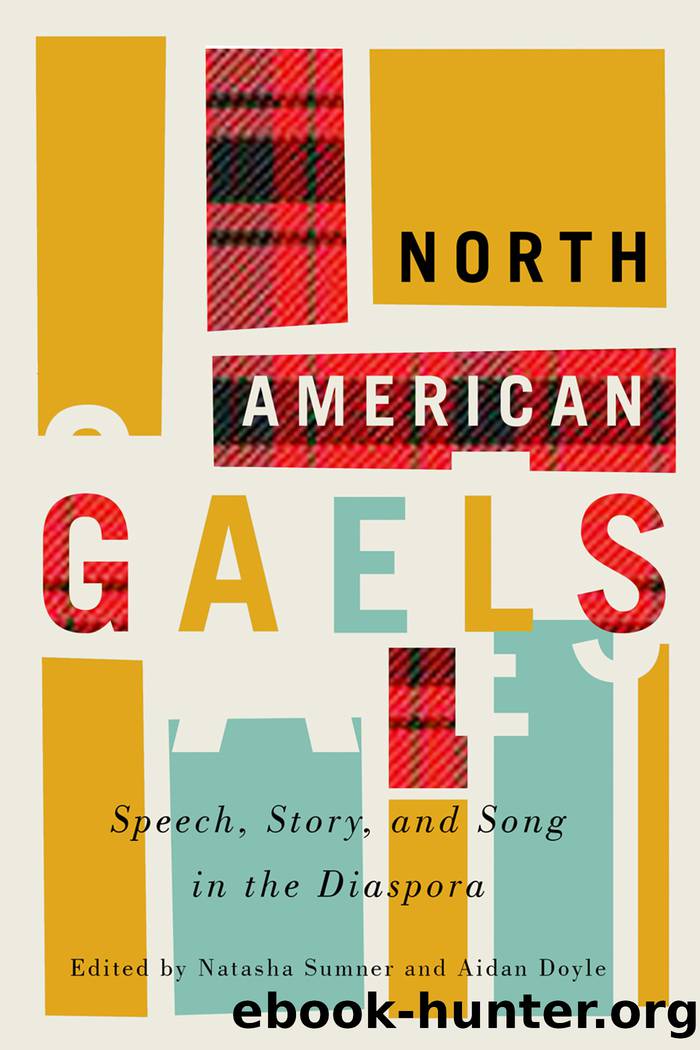North American Gaels by Sumner Natasha;Doyle Aidan;

Author:Sumner, Natasha;Doyle, Aidan;
Language: eng
Format: epub
Publisher: McGill-Queen's University Press
Published: 2020-08-15T00:00:00+00:00
9
âAgus céân chaoi ar thaithnigh na Canadas leat?â (And How Did You Like Canada?): Irish-Language Canadian Novels from the 1920s and 1930s
Pádraig à Siadhail
Kenneth E. Nilsenâs posthumously published essay on the Irish language in eastern Canada in the years 1750 to 1900 showcased his extensive research into, and expansive knowledge of, the presence of Irish speakers and their literary footprint in that region.1 It may seem strange to commence this discussion of early twentieth-century Irish-language novels about Canada by referring to a work noted by Professor Nilsen, namely, a mid-eighteenth-century macaronic poem set in Newfoundland, part of the earliest body of extant work in Irish from North America.2 In Donncha Rua Mac Conmaraâs âAs I was walking one evening fair / Is mé go déanach i mBaile Sheáinâ (And I lately in St Johnâs), the English-language lines relay the narratorâs positive experiences of the town and its inhabitants, including the womenfolk, as well as his loyal sentiments toward the British Crown and, particularly, George II and the House of Hanover. But the material in Irish subverts these statements, most tellingly in its pro-Jacobite closing lines, âIs a ChrÃost go bhfeiceadsa iad dá gcárnadh / Ag an mac seo ar fán uainn ag dul don Fhraincâ (Christ, may I see them pounded / by your son separated from us in France).3 Key to the poem is the sense that bilingual Irish- and English-speaking insiders would understand the context, the subtext, and the poemâs political message, whereas unilingual anglophone outsiders would miss the satire and the poetâs true intention. As we will see, this issue of different languages and different messages represents a significant point of divergence between Irish-language novels about Irish immigrants in Canada published in the 1920s and 1930s and similar-themed English-language texts published from the late nineteenth century to the present day. In the former, the main Irish-born characters return to Ireland; in the latter, their counterparts remain in Canada.
In this chapter, I outline and discuss the Canadian content in novels in Irish from the early decades of the twentieth century, compare these with Irish Canadian novels in English, and attempt to explain their contrasting approaches to settling in Canada.4
IRISH-LANGUAGE CANADIAN NOVELS
There are two main categories of English-language novels about the Irish immigrating to Canada. The first, historical fiction, has two subgenres. Patrick Slaterâs The Yellow Briar (1933) and Kathleen Coburnâs The Grandmothers (1949) are examples of what Jason King terms âIrish-Canadian immigrant memoirs,â in which the narrators recount their own lives or the lives of their families.5 A larger group of historical novels is set against the backdrop of the Great Famine and the consequent communal upheaval and emigration of the novelsâ characters. Prime examples of these texts include Robert Sellarâs âThe Summer of Sorrowâ (1895); Don Akensonâs At Face Value: The Life and Times of Eliza McCormack / John White (1990); Jane Urquhartâs Away (1993); and Peter Behrensâs The Law of Dreams (2006), winner of the 2006 Governor Generalâs Literary Award. There was a lengthy gap â
Download
This site does not store any files on its server. We only index and link to content provided by other sites. Please contact the content providers to delete copyright contents if any and email us, we'll remove relevant links or contents immediately.
The Power of Myth by Joseph Campbell & Bill Moyers(936)
Half Moon Bay by Jonathan Kellerman & Jesse Kellerman(920)
A Social History of the Media by Peter Burke & Peter Burke(886)
Inseparable by Emma Donoghue(853)
The Nets of Modernism: Henry James, Virginia Woolf, James Joyce, and Sigmund Freud by Maud Ellmann(772)
The Spike by Mark Humphries;(730)
A Theory of Narrative Drawing by Simon Grennan(712)
The Complete Correspondence 1928-1940 by Theodor W. Adorno & Walter Benjamin(711)
Ideology by Eagleton Terry;(665)
Bodies from the Library 3 by Tony Medawar(656)
World Philology by(649)
Culture by Terry Eagleton(648)
Farnsworth's Classical English Rhetoric by Ward Farnsworth(647)
Adam Smith by Jonathan Conlin(618)
A Reader’s Companion to J. D. Salinger’s The Catcher in the Rye by Peter Beidler(616)
Game of Thrones and Philosophy by William Irwin(604)
High Albania by M. Edith Durham(598)
Comic Genius: Portraits of Funny People by(588)
Monkey King by Wu Cheng'en(581)
